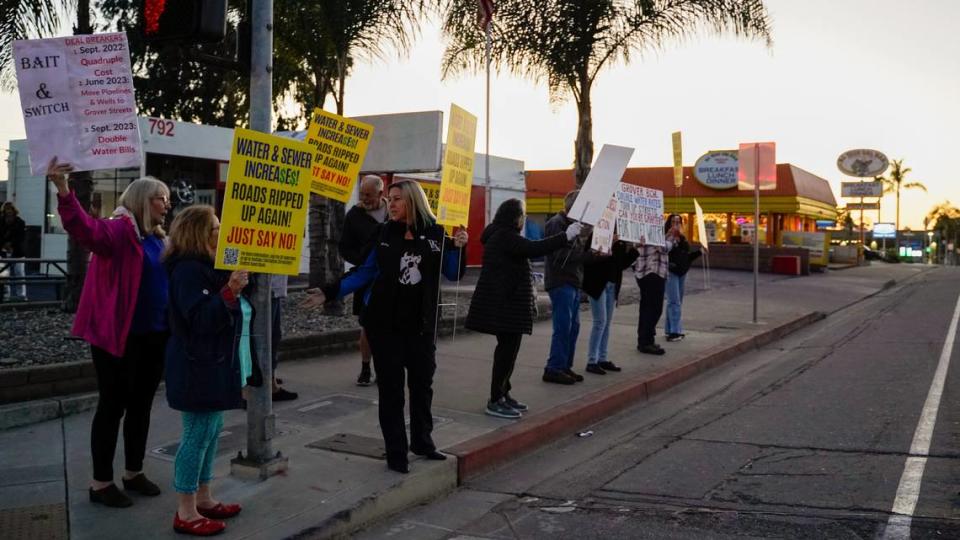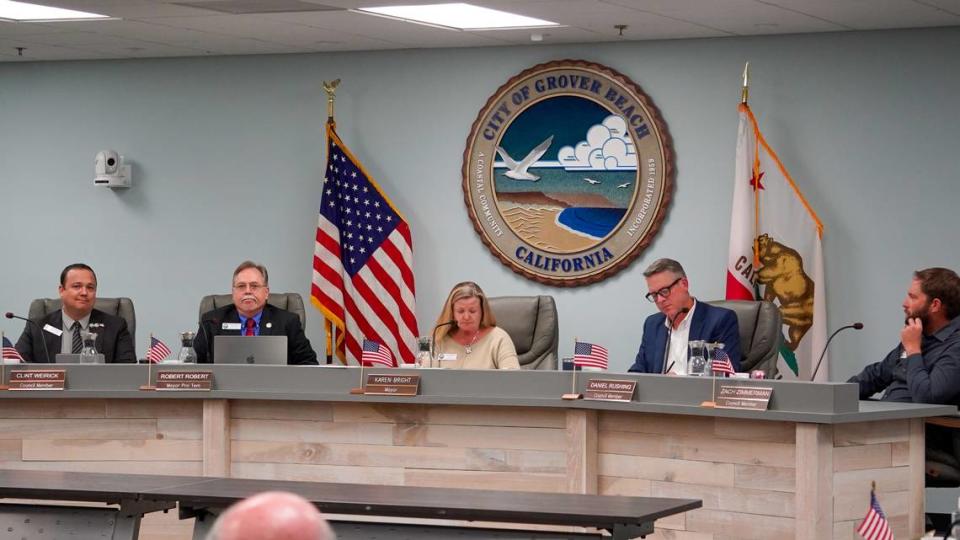Group pushes to recall Grover Beach mayor, council members after contentious water rate vote
Grover Beach residents’ water and sewer rates will rise over the next five years after an effort to protest a rate structure adjustment failed at a contentious City Council meeting Monday night.
At Monday’s meeting, the Grover Beach City Council voted 3-2 to approve a new rate structure with council members Robert Robert and Clint Weirick voting against the adjustment.
The adjustment in question — an as much as 91.8% increase to water and sewer bills over the next five years — was introduced to pay for the Central Coast Blue sustainable water project and other capital improvements to the city’s infrastructure.
Opposition to the rate structure change started building during the October noticing period required by California Proposition 218, which allows rate payers to reject a change in fees by gathering letters of opposition from more than 50% of rate payers.
On Monday evening, the protest effort fell short with a total of 1,687 protest votes against the rate structure, or around 34% of the city’s eligible voters.
As the protest votes were tallied and the vote to confirm the new rates approached, tensions rose at the meeting, with the audience of around 100 people spilling from the meeting room of City Hall to the overflow space.
“The fact of the matter is, there is still well over 60% of the population who did not protest,” Mayor Karen Bright said at the meeting as some members of the audience shouted and groaned.
Now, in the wake of Monday’s meeting, Bright and two City Council members — Daniel Rushing and Zach Zimmerman — are facing a recall effort from former Mayor Debbie Peterson and community members who protested the rate change.
Peterson, who started gathering signatures for a recall Monday evening, said high levels of community engagement around the water and sewer rate change may drive more residents to recall the City Council members.
“A lot of us had worked very hard over the last three months collecting signatures, and in a lot of cases there were whole streets where everybody on the street signed (the protest),” Peterson said. “Anywhere from 25% to half of the doors were opened by people who either said they had sent in a protest letter or signed one on the spot.”

Why did the City Council vote to raise water and sewer rates?
According to Grover Beach’s website on the project, the Central Coast Blue project will consist of an advanced water purification facility in the city that can treat water from Pismo Beach’s wastewater treatment plant before it is injected back into the groundwater basin.
That recycling of water could add 900 to 1,000 acre feet of water to the basin each year, and could provide Grover Beach with 324 to 360 acre feet of water a year, according to the city’s website.
The second phase will expand the new water purification facility, allowing it to purify water from the South San Luis Obispo County Sanitation District Wastewater Treatment Plant, and may require the construction of another three injection wells and six monitoring wells.
Work on the project started in 2016, with the project set to open in 2026, barring delays.
Funding has been a sticking point for the project along the way, as the price tag has ballooned from an expected $57 million two years ago to $93 million, though that increase was largely tied to the supply chain issues, inflation and design tweaks over the past few weeks, Water Systems Consulting consultant Justin Pickard said during the meeting.
According to Bright, the project has already received more than 40% of its funding through federal and state grants.
To cover the remaining costs, a Tuckfield & Associates study ordered by the city found water and sewer rates will need to rise by as much as 91.8%, broken up over the next five years, according to agenda documents.
Currently, Grover Beach ratepayers enjoy the lowest water and sewer bills in San Luis Obispo County, with the average single-family home with a 3/4-inch meter consuming 1,500 cubic feet of water every two months, averaging $90.69 per bimonthly payment, according to the rate study.
Under the new rate structure, customers will see rates rise as much as 28.5% in the 2023-24 financial year, 19.7% in the 2024-25 financial year, 19.8% in the 2025-26 financial year, 19.7% in the 2026-27 and 4% in the 2027-28 financial year, according to the rate study.
As part of the approved rate structure, the City Council will revisit the issue of water and sewer rates each year in the fall, city manager Matt Bronson said said.
The City Council also instructed staff to look into improving communications and messaging surrounding the rollout of the new rates, and asked the staff to look into expanding the city’s Utility Assistance Program.
The Utility Assistance Program was established in 2019. It currently serves 218 Grover Beach residents by using an annual pool of $50,000 to provide a monthly water and sewer bill credit, which has a value of around $58, Bronson said.

Opponents start recall campaign after protest vote fails
The city’s Nov. 13 council meeting was marked by a protest beforehand, followed by an extended public comment session as community members voiced opposition to the rate structure adjustment.
Though those protest efforts came up short, Monday’s meeting saw more of the same, with a protest before the meeting followed by extensive public comment against the project.
Peterson disputed the validity of the city’s protest vote count — saying she believed some protest votes were undercounted — and said the entire process was the wrong way to approach changes to rate structure.
“If you do not send in a letter of protest, you are counted as a vote in favor, and that makes it very, very difficult because in Grover Beach there are around 1,300 property owners who live out of town, and reaching them is difficult,” Peterson told The Tribune.
Many residents who attended the meeting said they were unhappy with the coming rise in monthly costs and said Central Coast Blue won’t do enough for Grover Beach to justify the cost.
“This water project is only beneficial for growth in Pismo, Arroyo Grande and Oceano, with absolutely no water benefits for Grover Beach,” former Mayor Richard Neufeld said during public comment. “We already have enough water, yet you want to approve spending up to $30 million of Grover Beach revenue so that the other cities can increase their population.”
Others doubted assurances from Bronson that rates would eventually come down during yearly evaluations.
“I’ve lived in Grover Beach for 40 years,” one resident said. “I have never seen a water rate decrease. It never goes down.”
At its most raucous, some members of the audience shouted over the City Council, so much that Bright ordered the council chambers cleared of all spectators — the first time she’s had to clear the chambers, she said.
“I just had a woman at my door today who did not speak because of that type of atmosphere,” Bright told The Tribune on Tuesday. “Everybody has a right to their opinion, no matter what it is. If you listen, you can come to a much better end result by compromising and hoping that you know you’re able to make things a little better for everybody.”

What happens next?
The rate changes are set to begin Feb. 1, 2024.
In the meantime, California’s recall guidelines require the proponents of a recall to serve the official in question with a notice of intention, informing them of the reasons for the recall and a minimum of 30 signatures, or three times the number of signatures required for the nomination paper when the official ran for office, whichever is higher.
A successful notice of intention would trigger a recall petition, which then has its own signature requirements based off of the number of registered votes in the jurisdiction.
For a Grover Beach recall to begin, Peterson said she’ll need to collect 60 to 90 signatures for each official the protest group hopes to recall.
She said she intends to have all signatures collected and paperwork submitted by March 1, 2024.
Bright said Peterson and the recall’s organizers “absolutely have the right” to challenge their elected officials for the policies they support, but asserted the rate adjustment was the only way to get the Central Coast Blue project funded.
Bright also said the recall wasn’t an unexpected move from a group of residents that she feels have opposed many of the City Council’s decisions.
“That’s a threat, and if they follow through, that’s their right to do so,” Bright said, “but I still feel like I have to do what’s right for the community and our future.”

